In part 1 of this series on the 1889 Union Church signature quilt, we learned about signature quilts in general, explored some of the unique characteristics of this specific quilt, and revealed the history of the Union Church. Now that the groundwork has been laid, let’s turn to some of the individual squares and the Libertyville people and businesses they represent.
People
Ansel B. Cook
When the quilt was made, Ansel B. Cook (1823-1898) had recently retired to his country home in Libertyville after a long and successful career in the masonry business in Chicago as well as being active in Chicago and state politics.
Mr. Cook’s signature is on the quilt, and his daughter and son-in-law, Ida and Dr. Albert Strong, had their own square with their children.
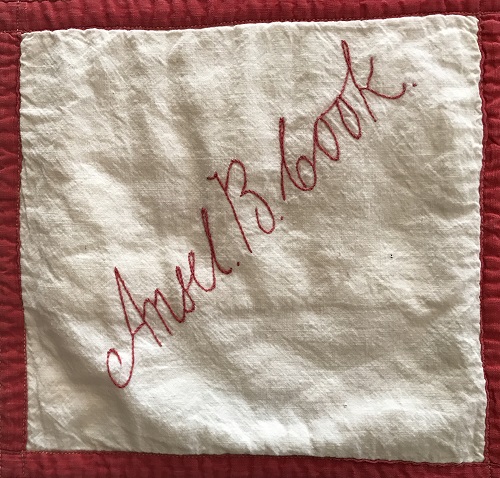 |
 |
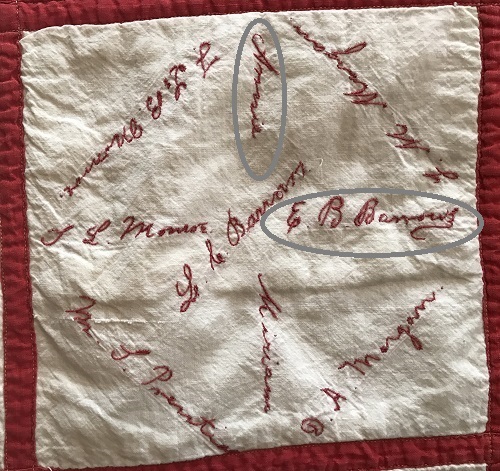 |
There is also a square representing the Barrows family of New Hampshire – the family of Mr. Cook’s second wife, Annie Barrows Cook. A year after her death in 1891, he would marry her sister E.B. Barrows [Emily].

In accordance with the wishes of her husband, Cook’s widow, Emily Barrows Cook, left the house and gardens to the Village of Libertyville following her death in December 1919. The Cook Memorial Library opened in the house in 1921 after fundraising and a few architectural changes intended to make the house look more like a civic building.
The Butler Family
Horace Butler (1814-1861), one of Libertyville’s earliest settlers, is not on the quilt, but his family is well represented. Horace came to Illinois from New Hampshire in 1837 after graduating from Dartmouth. He first moved to Chicago to study law before moving to Libertyville where he was the first lawyer in town. He was very active in public affairs and served as Justice of the Peace, Master in Chancery, probate justice, postmaster, and as a state representative. He had business interests in a Libertyville steam saw and flour mill. Today’s Butler Lake, which was on the west side of his property, bears his name.
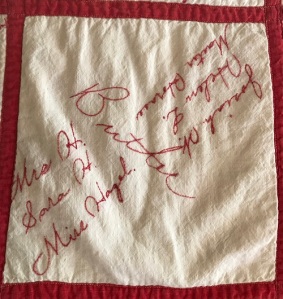 |
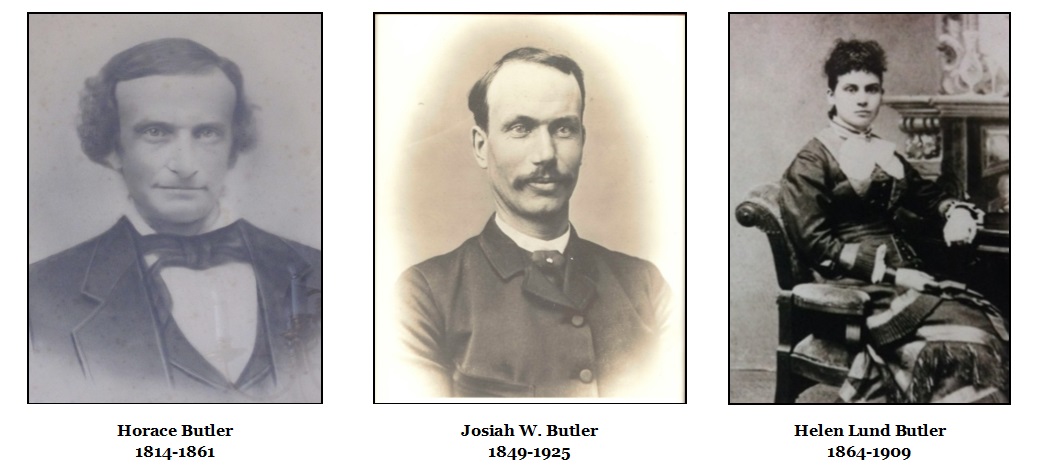 |
The Butler square includes Horace’s second wife, Mrs. H. Butler [Sara Ann Morse] (1820-1907), an early school teacher in Libertyville. Horace’s children, Sara H. (1851-1906) and Josiah W. (1849-1925) are also on the quilt. Josiah’s family as of 1889 all appear – wife Helen Lund Butler (1864-1909), toddler daughter Hazel (1887-1979) and infant son Horace (1889-1962). The couple would later have three more daughters – Bessie (1893-1976), Harriet (1895-1991), and Lucie (1898-1908). Helen Lund’s wedding dress is on display in the Ansel B. Cook Home in Libertyville.
Clara Averill Colby
Clara M. A. [Averill] (1878-1962) was just 11 years old when the quilt was sewn in 1889. A little less than 25 years later, she would become the first woman to vote in the state of Illinois. Clara came to Libertyville with her parents, C. H. [Charles] and Laura Averill of Milwaukee, Wisconsin in 1887. After attending the local school, she attended the Chicago College of Music and Education. She was the drama coach at Libertyville Township High School for many years. She married Elhanan Wayne Colby, a prominent lawyer and eventual mayor of Libertyville, in 1905. They had one son, John.
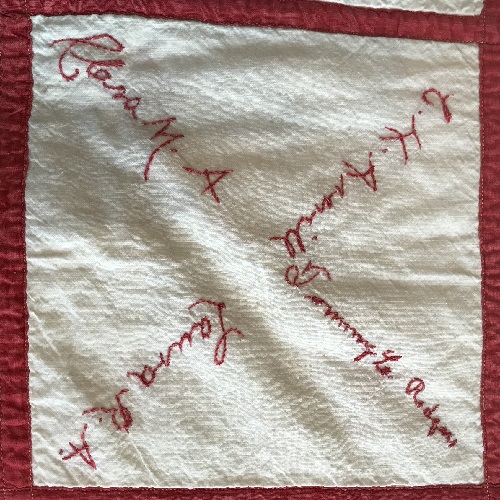
On June 26, 1913, Governor Edward F. Dunne of Illinois signed the Suffrage Bill that gave Illinois women the right to vote in elections for president, other offices not governed by the state constitution, and local option elections (referendums). The new law made Illinois the first state east of the Mississippi River to grant women the right to vote for President of the United States. Libertyville held an election concerning a new village hall on July 5, the first election scheduled after the suffrage law went into effect. Clara Averill Colby was the first to vote that day.
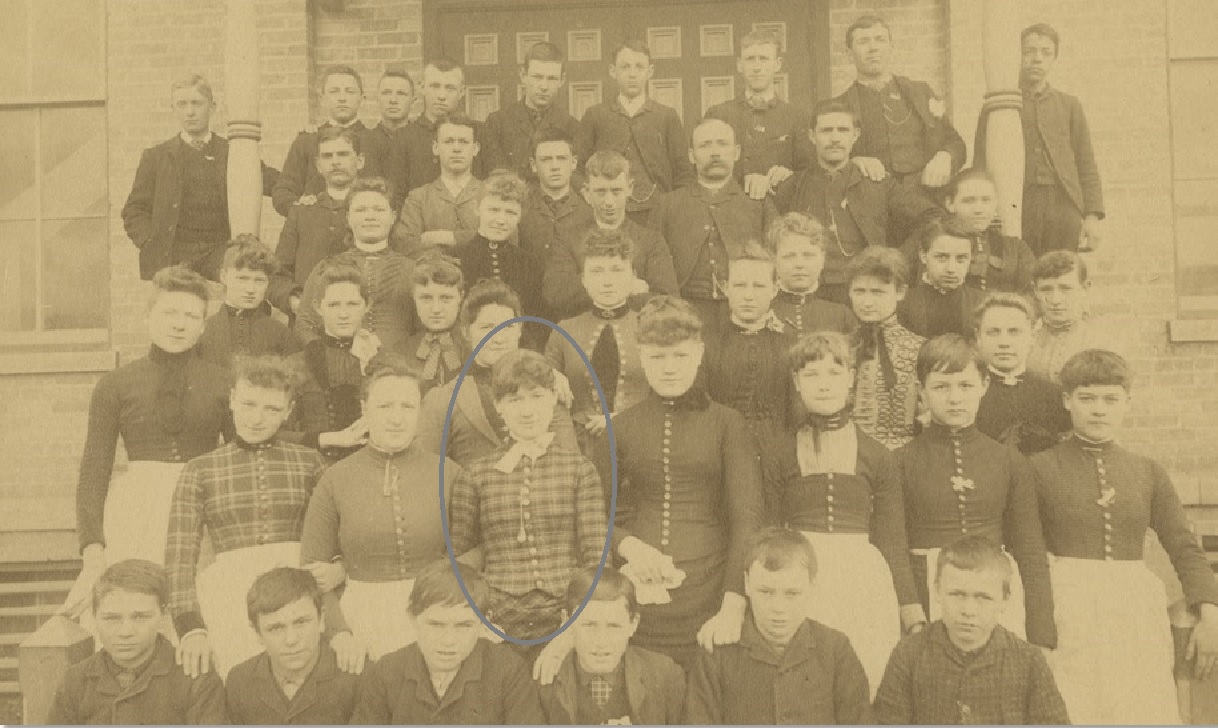
E. W. Parkhurst (1844-1927) was born in Vermont and moved to Libertyville at age 11. In addition to his business concerns, he served as postmaster for eight years and as township assessor. He was a member of the Libertyville Wide Awakes, president of the Lake County Agricultural Association, a founder of the Lakeside Cemetery Association and the Libertyville Universalist Church, and a past master of the local Masonic Lodge. He was also on the board of directors of the organization that brought the railroad to Libertyville. Mr. Parkhurst’s fine home, built in 1891, is now the Burnett-Dane Funeral Home.
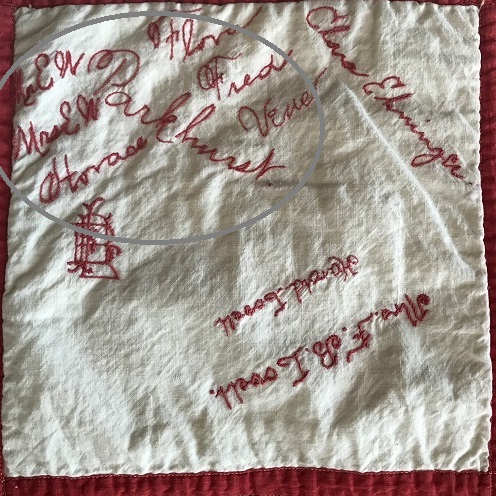 |
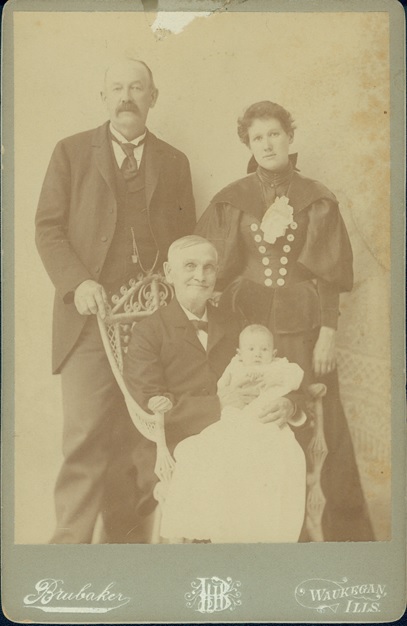 |
Franklin P. Dymond (1852-1948) was born in Jefferson, Illinois. His family settled in Libertyville in 1864 and farmed along what is now Dymond Road. He completed a course at the Bryant & Stratton Business College in Chicago and then went to work for George Schanck in Libertyville before partnering with Parkhurst. Dymond was also active in public affairs. He served on the school board and was elected mayor in 1887.
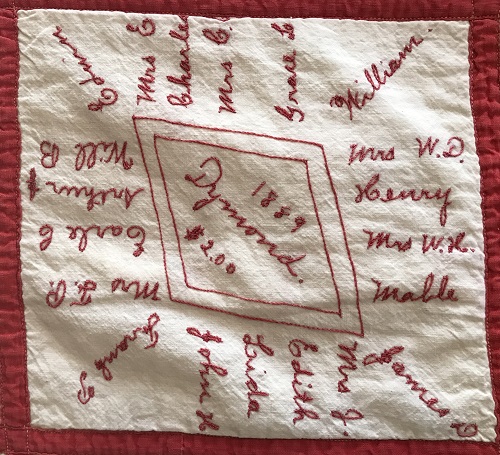 |
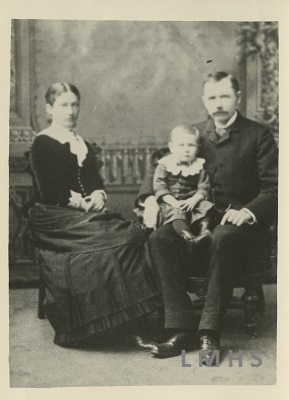 |
Businesses
Parkhurst & Dymond
E. [Edwin] Parkhurst and Frank [Franklin] P. Dymond established Parkhurst & Dymond, “dealers in fancy groceries”, in February 1882. The store opened in the second storefront of the Knight building next to the Kimball & Knight drug store (see below). Parkhurst & Dymond did very well with sales amounting to $30,000 (almost $700,000 in 2018 dollars) in their first year. In addition to dry goods, groceries and other general merchandise, they were an agency for Home Sewing Machine and Hartford Fire Insurance Co. The two gentlemen, along with George Wright, went on to form the banking house of Wright, Parkhurst and Dymond in 1892, the first bank in the village. The bank occupied a brick building at 525 N. Milwaukee Avenue before building on the northwest corner of Cook and Milwaukee Avenues in 1894 (currently home to the Picnic Basket restaurant). In 1923, the bank built another new building just to the north, currently occupied by Libertyville Bank and Trust.
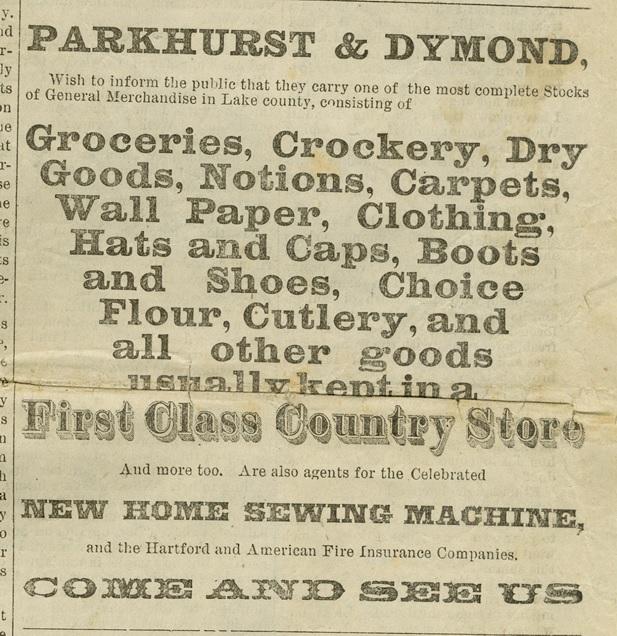
The Syndicate
In 1892 a real estate investment company formed with big plans to promote Libertyville. Known as the “Syndicate,” members included Libertyville businessmen Franklin Dymond, John Woolridge, C.F. and George Wright, H. S. Hurlbutt, and Robert Proctor, along with W. T. Eaton and Mat Pinkerton of Chicago.
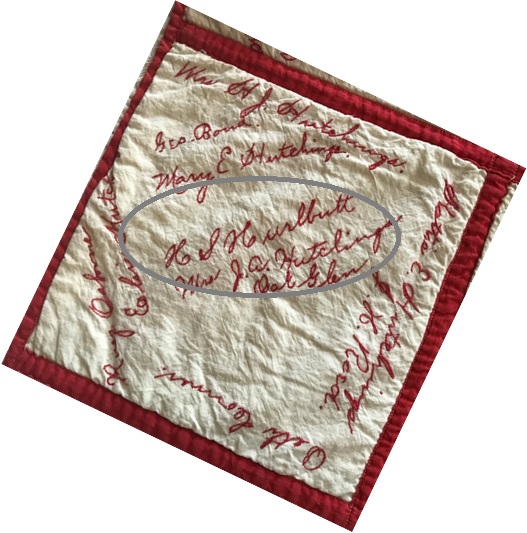 |
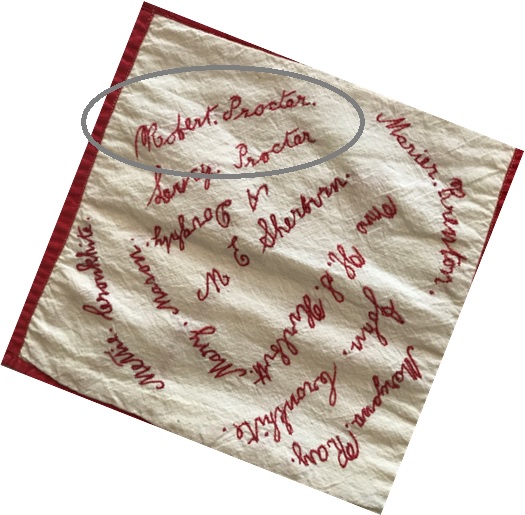 |
The Syndicate purchased 525 acres of land on the east side of Milwaukee Avenue and subdivided part of the land into lots for residential development. This area became known as the C. Frank Wright Addition. Another section of the land was set aside for manufacturing purposes. In 1894 the Syndicate erected a three story brick factory, apparently as speculation. Located on today’s Church Street, east of the downtown core, the building did attract new industry, but the first contract for occupation fell through. Finally in 1898 the Earl Ladder Company was the first to use the building. Later, it became the iconic home of the Foulds Macaroni Company.
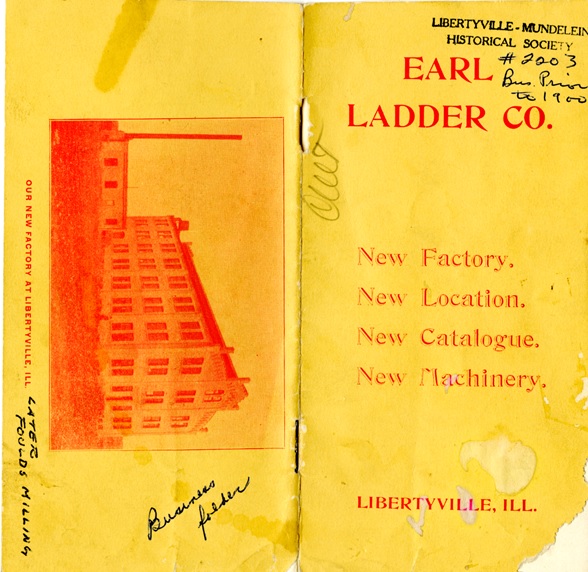
Isaac Heath & Sons
Isaac Heath (1832-1898) arrived in Lake County from Vermont in 1853. He was a carpenter and joiner and established his business in 1865. Isaac later operated a furniture and undertaking business with his sons, Omar and Warren M. Heath, and served as Libertyville’s postmaster from 1876 to 1885. He built many of the downtown buildings, including the Heath building built in 1883. The building is still standing at 521 N. Milwaukee Avenue, but the name and date in the cornice is no longer visible. After Isaac’s death in 1898, his son Warren continued the business until about 1908.
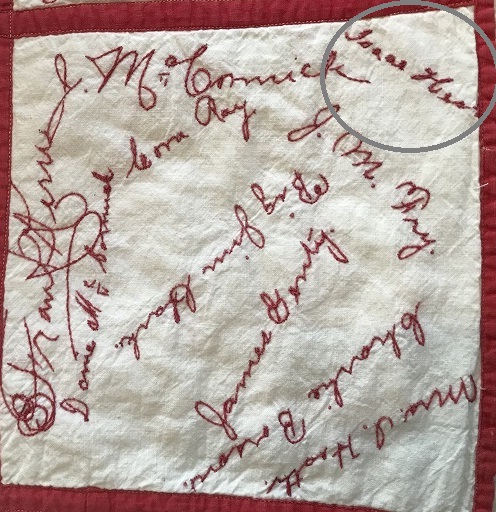 |
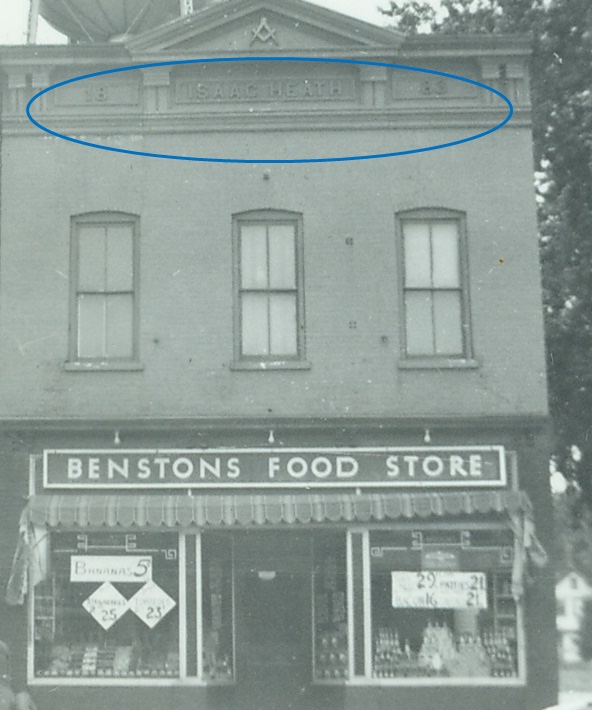 |
Abana Spring Water
F. [Frederick] Grabbe (1842-1915), a German immigrant and Civil War veteran, established a flax and feed mill on Milwaukee Avenue at Newberry Avenue around 1882. Sometime later in that decade, Grabbe started a water bottling concern, Hygiene Spring, becoming the first Libertyville citizen to exploit the natural spring waters that ran under the village.The name changed to Abana Springs, referring to an ancient river near Damascus, about 1902. The frame building shown here stood on Newberry Avenue. A second location on Park Place was purchased in 1908 to keep up with demand for the bottled water. Abana Springs ceased operations upon the death of Frederick Grabbe in 1915.
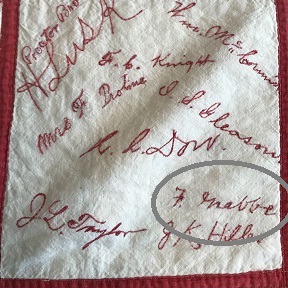 |
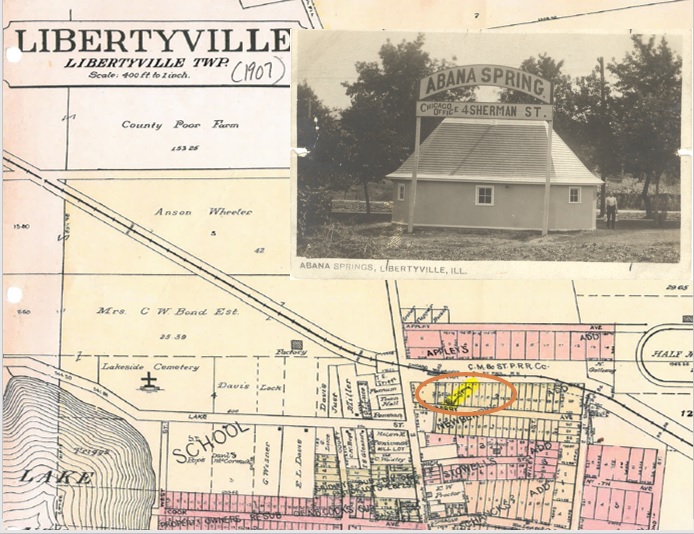 |
Mrs. H.S. Hurlbutt and Mrs. F. Protine
Libertyville was served by a few women proprietors in the 1880s. Mrs. H.S. Hurlbutt and Mrs. F. Protine operated millinery shops, practically next door to each other on Milwaukee Avenue.
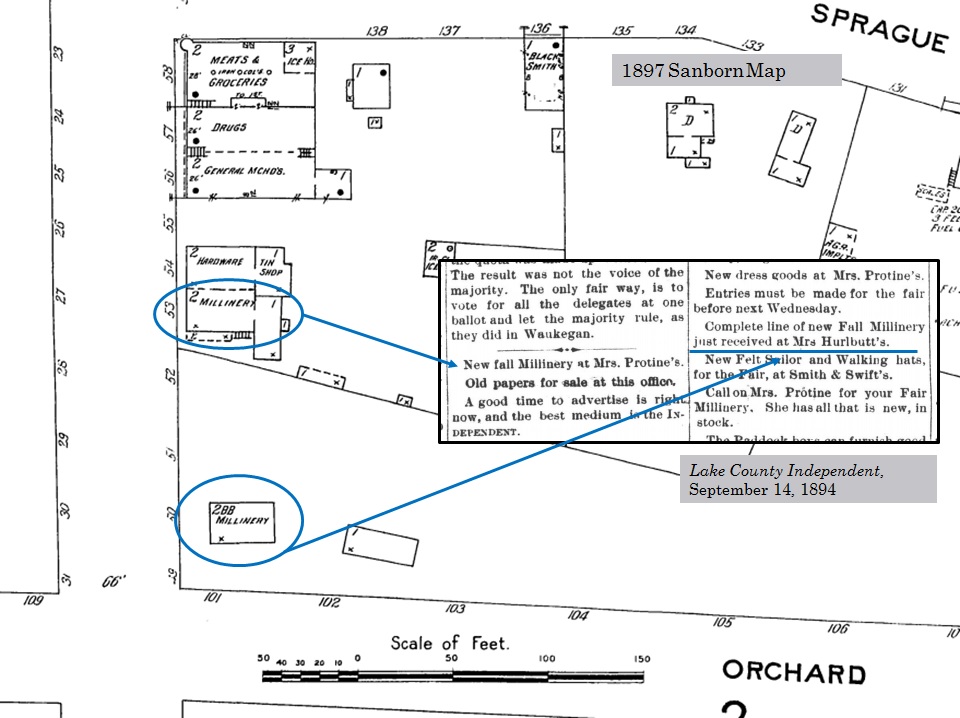
Mrs. H.S. Hurlbutt was born Caroline Carfield in 1852 to John and Ann Carfield. She married Henry S. Hurlbutt in 1871. After moving to Libertyville she and her husband bought a building and millinery business from Mr. and Mrs. M. H. Seavy. Mrs. Hurlbutt was in business until 1908 when poor health forced her retirement. She would live until her mid-80s, passing in 1936.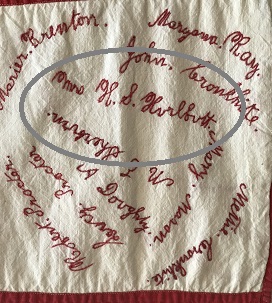
Martha Ann Davis Protine was born in Libertyville to Phillip and Elizabeth Davis. She married Francis Protine, a tin smith, in 1874 and operated her millinery business next door to his hardware store and tin shop for around 30 years. In addition to running the millinery shop, Mrs. Protine was a member of the Libertyville Woman’s Club, the Rebekah Lodge, the Royal Neighbors, and the Mystic Workers. She died in 1926.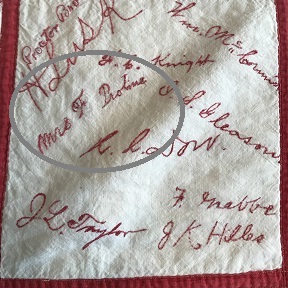 Kern Hotel
Kern Hotel
Henry Kern established the Kern Hotel in 1881 on the corner of First Street and Orchard [Church Street]. His son, Frank Kern, represents the family on the quilt.
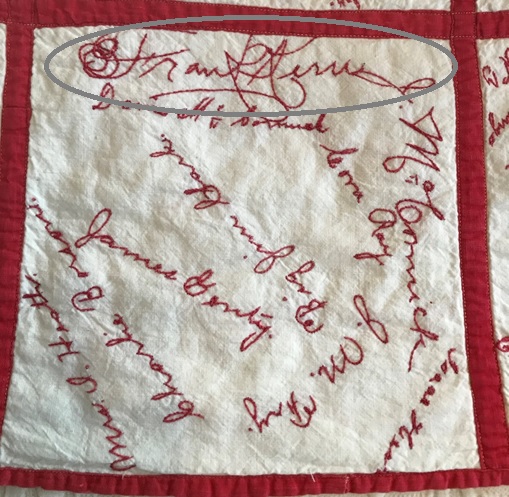 |
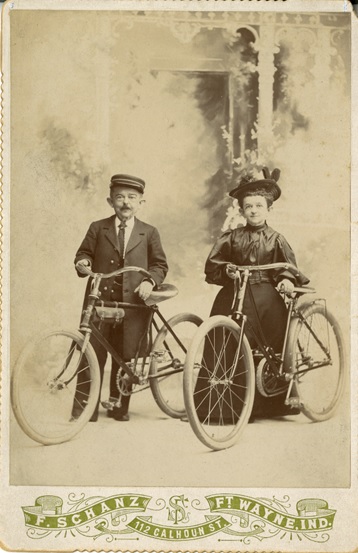 |
Famous, and frequent, guests at the Kern Hotel were Charles and Eliza Nestel, little people known as Commodore Foote and the Fairie Queen. They spent a portion of almost every summer at the Kern Hotel. Said Eliza of Libertyville: “I have been almost constantly traveling for twenty-five years and more, but never discovered such a charming village as Libertyville, which I have visited many times.” Commodore Foote even attended Henry Kern’s funeral in 1918. Mr. F. E. Clarke and his wife took over the hotel about 1897. Mrs. F. E. Clarke was lauded for her cooking and Mr. Clarke was a genial host. The Kern Hotel operated under that name until at least 1905.
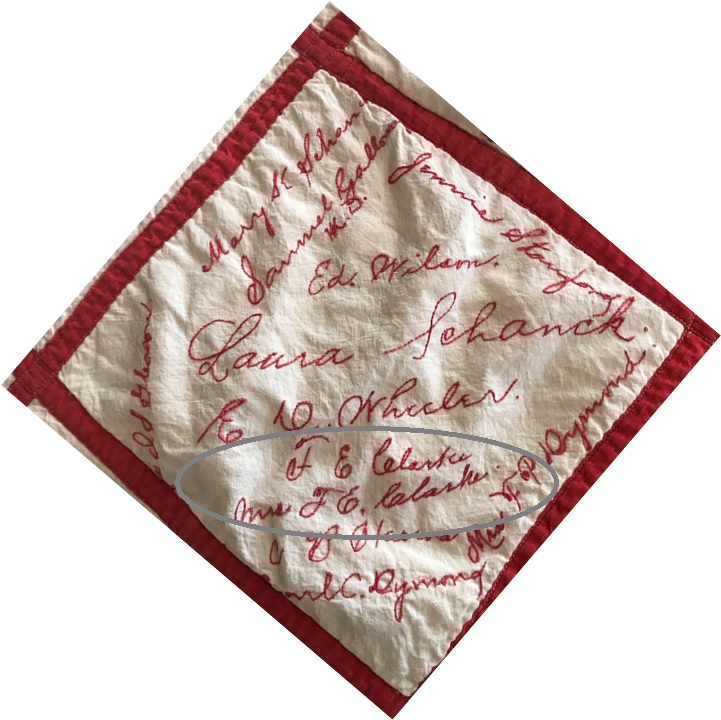
Kimball & Knight/F.B. Lovell
Frank Zeno Kimball, born in 1851, arrived in Lake County from Vermont in 1872. He taught school from 1874 to 1876 before going into the drug store business. After an 1880 fire destroyed his business and residence, he partnered with Dr. F. C. [Fremont] Knight, a recent arrival from New York, to build a new building and enterprise.

In January 1882, Kimball & Knight’s Drug Store opened for business in their new building on the east side of Milwaukee Avenue, just south of Sprague Street [Cook Avenue]. By 1883, the store’s name had changed to F. Z. Kimball & Co., and eventually the business passed to Frank B. Lovell. It was in the back of Lovell’s drug store where Libertyville’s telephone service was established in 1898. After Frank’s death in 1910, his wife, Mrs. F. B. Lovell [Augusta Messer], continued the business in partnership with pharmacist James Swan. 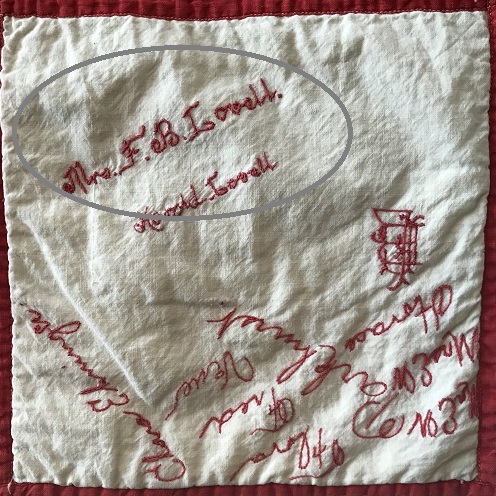
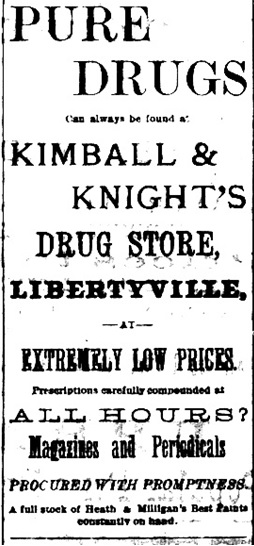 |
 |
In the late 1940s, pharmacist L. J. Petranek bought the business and eventually changed the name from Lovell’s to Petranek’s.
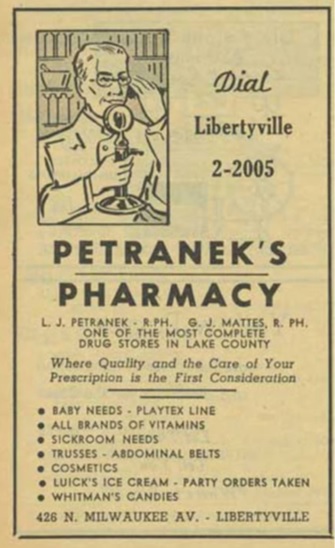
This is just a glimpse at a few of the people and businesses represented on the quilt. In the next post, we will explore the quilt’s ties to significant Libertyville events of the late 1800s.
- 1870, 1880, 1900 U.S. Census, Libertyville, IL
- Barry, Jenny. “Who Was Ansel B. Cook?” The Past is Present, Cook Memorial Public Library blog. https://shelflife.cooklib.org/2016/11/06/who-was-ansel-b-cook-part-1/
- Biographical Sketch from Horace Butler collection at the Illinois State Library.
- “Untimely Death of an Old Resident.” Lake County Independent, September 6, 1907.
- “J.W. Butler Passes Away.” Libertyville Independent, October 15, 1925. p.1.
- “Two New Names on Death’s Roll.” Lake County Independent, August 27, 1909.
- “Death of the Hon. Horace Butler.” Waukegan Weekly Gazette, March 16, 1861.
- “Hazel Butler.” Independent Register, September 27, 1979, p.12A.
- “Butler.” Waukegan News Sun, 26 Dec 1991, p. 3D
- “Kern Hotel.” Lake County Independent, September 25, 1903
- “Henry Kern.” Portrait and biographical album of Lake County, Illinois.Chicago : Lake City Pub., 1891
- “For F.S. Kern.” Independent Register, 14 Mar 1946, p. 4
- “Henry Kern.” Libertyville Independent, 19 Dec 1918, 1, p. 1
- “E.W. Parkhurst.” Lake County Independent, September 25, 1903.
- “Dymond Rites are Held on Monday.” Independent Register, September 16, 1948, p.1.
- Business Review.” Lake County Independent, June 26, 1896, p.1.
- “At Rest.” Lake County Independent, April 11, 1902, p.1.
- Schoenfield, Sonia. “Banking on Libervtyille.” The Past is Present, Cook Memorial Public Library blog. https://shelflife.cooklib.org/2016/11/26/banking-on-libertyville/
- Libertyville Illustrated. Chicago : Kehm, Fietsch & Miller Co. Press, 1897.
- Lane, Arlene and Sonia Schoenfield. “Fould’s building has many stories to tell.” Libertyville Review, July 1, 2010.
- “At the Factory.” Lake County Independent, June 24, 1898, p.5.
- Earl Ladder Company. Brochure. Libertyville-Mundelein Historical Society. Ca. 1898.
- “About the Factory.” Lake County Independent, 25 Jun 1897, p. 5
- “Will Start July 1.” Lake County Independent, June 11, 1897, p.5.
- “Come and Go.” Lake County Independent, November 5, 1897, p.1.
- “Earl Manufacturing Co., of Schoolcraft, Mich., Will Remove to Libertyville.” Lake County Independent, June 10, 1898, p.5.
- “Hello Everybody! Libertyville to have telephone service.” Lake County Independent, February 11, 1898, p.5.
- 1950 Libertyville telephone book
- Libertyville Times, August 23, 1883
- Our Businessmen.” Profiles of local businesses in 1882 copied from a scrapbook lent to the library by Anna Appley in 1955.
- Petranek’s Pharmacy advertisement. The Nautilus, 1958. Libertyville High School.
- Kimball, Frank Z. The Past and Present of Lake County, Illinois. Chicago, Wm. Le Baron, 1877, p.407.
- Libertyville Telephone Directory, 1949, 1950.
- “Store Has Rich History.” Independent Register, April 26, 1956, p.11.
- 1870 U.S. Census for Libertyville, IL. Ancestry.com. Accessed December 15, 2017.
- 1880 U.S. Census for Libertyville, IL. Ancestry.com. Accessed December 15, 2017.
- Norwich University catalog, 1875. Ancestry.com. U.S., School Catalogs, 1765-1935. Accessed November 29, 2017.
- Norwich University catalog, 1871. Ancestry.com. U.S., School Catalogs, 1765-1935. Accessed November 29, 2017.
- “Vermont Volunteer Militia.” The Burlington Free Press (Burlington, VT), December 25, 1871. p.3.
- Francis “Frank” Zeno Kimball. FindaGrave.com. Accessed December 15, 2017.
- Frank Z. Kimball and Nellie F. Stowell. Illinois, Marriage Index, 1860-1920. Ancestry.com. Accessed December 15, 2017.
- Deed. Lyman S. Wilson to Lorenzo Stowell. October 21, 1872. Book 50, page 237. Lake County Recorders of Deeds office.
- “Many of our citizens will remember…” Green-Mountain Freeman (Montpelier, VT), February 11, 1880, p.3.
- “Fire at Libertyville.” Waukegan Weekly Gazette, February 7, 1880, p.3.
- “Mr. Stowell’s losses…” Waukegan Weekly Gazette, February 7, 1880, p.2.
- Deed. Lorenzo Stowell & Olive Stowell to Frank Z. Kimball. August 27, 1881.
- Deed. Lorenzo Stowell & Olive Stowell to Frank Z. Kimball. August 27, 1881.
- “Death Takes Nellie Kimball.” Independent Register, January 16, 1941, p.1.
- “Fremont C. Knight, M.D.” Portrait and Biographical Album of Lake County, Chicago : Lake City Pub., 1891. p. 489-90.
- “Building Boom.” Independent Register, Centenntial Edition…..
- 1901 Waukegan, IL City Directory. Ancestry.com. Accessed January 6, 2018.
- “Fremont C. Knight, M.D.” Portrait and biographical album of Lake County, Illinois, Chicago : Lake City Pub., 1891.
- “Dr. Fremont Knight is Dead.” Herald Examiner, April 30, 1931.”
- “Dr. F.C. Knight of Waukegan is Taken by Death.” Chicago Daily Tribune, May 1, 1931, p.22.
- “Death removes a splendid citizen.” Lake County Independent, April 29, 1910, p.5.
- “Frank Lovell, The Citizen.” Lake County Independent, May 6, 1910. p.5.
- William Henry Appley Diary, Volume 1, 1889-1897. Illinois Digital Archives, http://www.idaillinois.org/cdm/compoundobject/collection/cookmemo11/id/5573/rec/1. Accessed January 6, 2018.
- “Frank B. Lovell.” Lake County Independent, September 25, 1903, Special Souvenir Edition, p.4.
- “Houses of Milwaukee Avenue, 527 N. Milwaukee Avenue. http://vitacollections.ca/cmpldnewsindex/441/Exhibit/6
- Barry, Jenny. “Frederick Grabbe and Abana Spring Water.” The Past is Present, Cook Memorial Public Library blog. https://shelflife.cooklib.org/2017/05/17/frederick-grabbe-and-abana-spring-water/
- Protine, Martha. Libertyville Independent, 25 Feb 1926, 1, p. 4
- Protine, Frank. Lake County Independent, 3 Mar 1905, p. 5
- Hurlburt, Caroline. Independent Register, 12 Nov 1936, p. 1
- Hurlburt, Henry. Libertyville Independent, 17 Feb 1921, 1, p. 5
Categories: Local History
Tags: Local History
